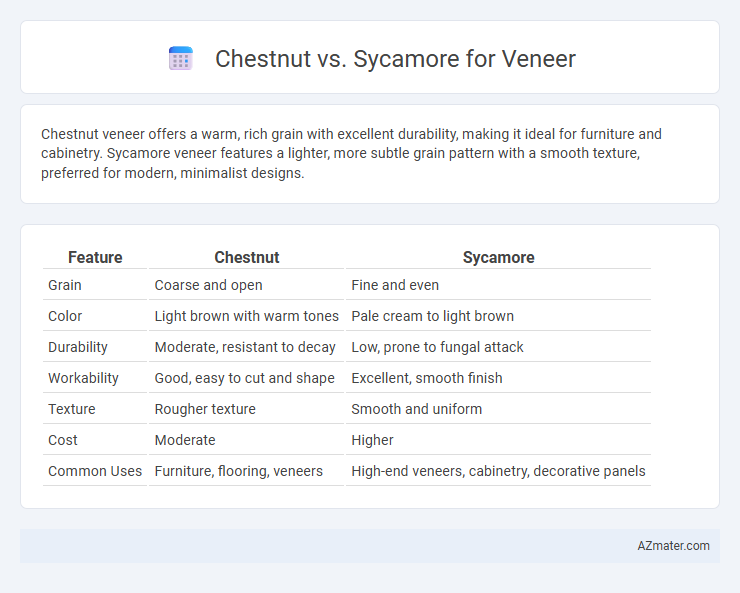Chestnut veneer offers a warm, rich grain with excellent durability, making it ideal for furniture and cabinetry. Sycamore veneer features a lighter, more subtle grain pattern with a smooth texture, preferred for modern, minimalist designs.
Table of Comparison
| Feature | Chestnut | Sycamore |
|---|---|---|
| Grain | Coarse and open | Fine and even |
| Color | Light brown with warm tones | Pale cream to light brown |
| Durability | Moderate, resistant to decay | Low, prone to fungal attack |
| Workability | Good, easy to cut and shape | Excellent, smooth finish |
| Texture | Rougher texture | Smooth and uniform |
| Cost | Moderate | Higher |
| Common Uses | Furniture, flooring, veneers | High-end veneers, cabinetry, decorative panels |
Introduction to Chestnut and Sycamore Veneers
Chestnut veneer is prized for its warm, rich brown tones and distinctive grain patterns, making it an ideal choice for traditional and rustic interior designs. Sycamore veneer offers a lighter, creamy color with subtle, fine grain that suits modern and minimalist aesthetics, providing a clean and bright appearance. Both veneers are valued for their durability and workability, but chestnut delivers more pronounced visual texture while sycamore emphasizes smoothness and uniformity.
Botanical Origins and Tree Characteristics
Chestnut veneer, derived from trees in the genus Castanea, is known for its dense, durable wood with a coarse, straight grain and a warm, brown tone, making it ideal for rustic furniture and cabinetry. Sycamore veneer, sourced from the Platanus genus, features a lighter, creamy color with a fine, uniform grain and a smooth texture, often displaying distinctive swirling or mottled patterns prized for decorative paneling. Castanea species thrive in temperate climates, growing tall with sturdy trunks, while Platanus species are fast-growing, adaptable trees commonly found in riparian environments, influencing the wood's grain complexity and stability.
Wood Grain and Aesthetic Differences
Chestnut veneer features a straight, coarse grain with a warm, golden-brown hue that deepens with age, offering a rustic and classic appearance. Sycamore veneer showcases a finer, often wavy or mottled grain with a light cream to pale brown color, lending a more contemporary and elegant aesthetic. The contrasting grain patterns and color tones make chestnut ideal for traditional designs, while sycamore suits modern interiors requiring subtle texture and brightness.
Color and Appearance Comparison
Chestnut veneer offers a warm, rich reddish-brown hue with a fine, straight grain that enhances traditional and rustic designs, while sycamore veneer features a lighter, creamy to pale yellow color with subtle, wavy grain patterns providing a more delicate and contemporary aesthetic. Chestnut's darker tones create a bold, classic appearance, whereas sycamore's brightness and fine texture lend an airy, modern feel to interiors. The contrast between chestnut's deep warmth and sycamore's soft neutrality makes each distinctly suited for varied decorative applications and design preferences.
Durability and Hardness for Veneer Use
Chestnut veneer offers moderate durability with a Janka hardness rating of approximately 540, making it suitable for light to moderate wear applications. Sycamore veneer, with a hardness around 950 on the Janka scale, provides greater resistance to dents and wear, ideal for high-traffic areas or heavy-use furniture. Both veneers present attractive grain patterns, but sycamore's superior hardness enhances its longevity and ability to withstand daily use.
Workability and Machining Properties
Chestnut veneer offers excellent workability due to its fine, even grain and moderate hardness, allowing for smooth cutting and sanding with minimal tool wear. Sycamore veneer, while slightly harder and denser, provides good machining properties but may require sharper tools and slower feed rates to avoid burnishing or tear-out. Both woods respond well to finishing, but Chestnut's softer nature makes it more versatile for intricate detailing and precise joinery in veneer applications.
Common Applications in Veneer Industry
Chestnut veneer is widely used in high-end furniture, wall paneling, and decorative cabinetry due to its attractive grain and warm, rich tones that enhance luxury interiors. Sycamore veneer is favored for commercial interiors, including office furniture, retail fixtures, and acoustic panels, thanks to its light color and uniform texture that provide a modern, clean aesthetic. Both veneers offer versatility, but chestnut is preferred for traditional and rustic designs, while sycamore suits contemporary applications requiring a sleek, minimalist look.
Environmental and Sustainability Factors
Chestnut veneer offers superior sustainability due to its rapid growth rate and abundance in temperate regions, reducing deforestation pressure compared to slower-growing sycamore. Sycamore veneer, while prized for its fine grain and durability, often comes from older, less renewable sources, leading to higher environmental impact over time. Utilizing chestnut supports eco-friendly forestry practices by promoting faster replenishment cycles and minimizing habitat disruption.
Cost and Availability of Veneer Sheets
Chestnut veneer sheets are generally more affordable due to their wider availability in Europe and North America, while sycamore veneer tends to be pricier because of its relative rarity and limited supply. Chestnut's consistent growth and sustainable harvesting practices contribute to steady market availability, whereas sycamore is harvested less frequently, impacting its cost and accessibility. For projects on a budget, chestnut offers a cost-effective veneer option without compromising quality, while sycamore suits premium applications requiring unique grain patterns despite higher costs.
Choosing Between Chestnut and Sycamore for Veneer Projects
Chestnut veneer offers rich, warm tones with distinctive grain patterns ideal for traditional or rustic designs, while sycamore veneer provides a lighter, more uniform appearance suited for modern and sleek aesthetics. Both woods are durable, but chestnut tends to have a tighter grain, enhancing durability and resistance to wear in high-traffic furniture. Choosing between chestnut and sycamore veneers depends on the desired visual impact and the specific application requirements of the project.

Infographic: Chestnut vs Sycamore for Veneer
 azmater.com
azmater.com